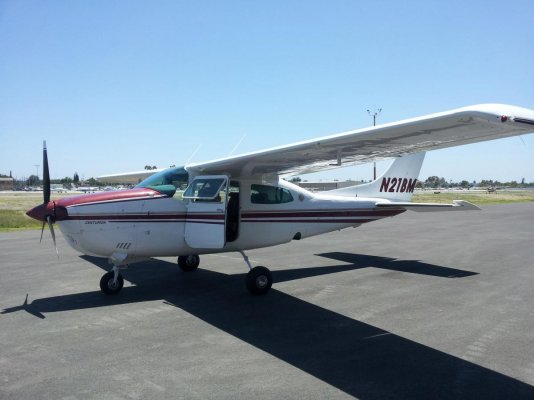I do appreciate the cantilever wing on the 177 Cardinal but I like the T210 wing even better!

I heartily agree!! Even better was the Robertson Conversion kit on the T210 wing. My chief flight instructor at our FBO taught me how it'll fly out of ground effect with the airspeed needle
just barely coming off the peg...I think it pegs at 40 kts. It's an amazing performance kit on an already great performing airplane!! One of my single-engine favorites.
My uncle and godfather owned one of the last 210s built. I think it was 1986. It was normally aspirated since he lived and flew in the Midwest. The unusual aspect of that plane was the upturned wingtips rather than the downturned cambered wingtip. It looked cool and reportedly enhanced the performance more than the cambered tips. Not too many were made like this before production was suspended in 1986. Another favorite 210 model was the pressurized P210. It was quiet, fast and comfortable, but the visibility was reduced due to the smaller windows.
Of the Cessna recip line, I never had the opportunity to fly the 340 or 421 twins, but liked the 310 and 402. Got a couple of flights in the 303 Crusader, but was not impressed. Surprisingly, the 337, pressurized and non-P, was a fun and fast flying plane. The T182RG was also an impressive performer. We flew a lot in AZ, so I liked the 172XP for its hot and high capability improvements over the 172. And the 152 acrobat was just plain fun!
I never owned an airplane. Never had the resources to afford it, but flew them professionally for most of my 40 years of flying. Each upgrade was a flight full of discovery and new experiences and I almost always liked the latest airplane the best.
One exception was in an airplane that I liked and was very reliable and efficient, but it wasn't well suited for our mission of NAVAIDS flight inspection throughout the western United States. I had been flying a Rockwell Saberliner 80 (similar to the 75A) in the late 1980's when Congress, at the direction of DOT Secretary Elizabeth Dole, approved the purchase of 19 King Air 300s which were the end of the production run for Wichita, KS based Beechcraft where she and her husband, Bob Dole, practiced their own brand of politics. Beechcraft was eager to move onto the King Air 350 with Part 23 certification instead of the 300's Special Part 41C certification and needed to unload these albatrosses from their neck. So the FAA got these 300's crammed down their throats for a mission for which it was ill-suited. These planes were outdated when purchased and have been money pits for the FAA since then. They are now spending more than $1M per plane to bring the cockpits and navigation systems up to date.
When we moved to the Learjet 60 in the mid-1990's, we returned to being able to fly to any destination in our area of responsibility and conduct the 2+ hrs flight inspection mission without refueling during our lunch stop. Our speed, efficiency, comfort (ie less fatigue, turbulence effect and noise) and full nav capability returned and exceeded that of the Saberliner. That was the plane I flew until I retired from the FAA after flying it for 17 years. It's still my favorite!
I like to say that I used to cruise at 8 miles per minute and now I cruise at 8 miles per hour... and I'm still having loads of fun!








